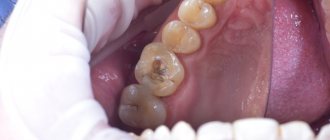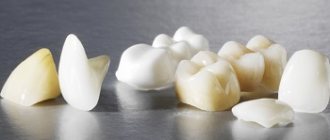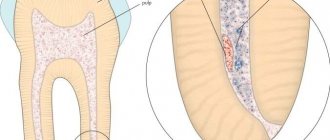Indications
The cavity located inside the tooth, where the nerve endings and blood vessels are located, is called the pulp. If the caries lesion is not treated in a timely manner, the pathology reaches the pulp, which leads to the occurrence of an inflammatory process called pulpitis. The process does not go away on its own; the pain that inevitably arises is removed by painkillers in the initial stages. Over time, they also stop working. In advanced cases, inflammation spreads to the bone, which leads to periodontitis and, as a consequence, osteomyelitis. The main indication for root canal filling is pulpitis caused by caries.
Filling methods
Until recently, the procedure was carried out using pastes, which are inexpensive and do not require complex technologies. Now professional dentists have abandoned them due to insufficient fluidity, which leads to the formation of cavities. Voids lead to depressurization and relapse of inflammation.
At the moment, doctors choose progressive methods:
- Thermophile system. The filling is performed with hot gutta-percha, which hardens as it cools. It is characterized by high plasticity. There is no pain after treatment. The risk of complications is minimal;
- depophoresis. It is used for filling difficult, curved canals, as well as for restoring elements from which it is difficult to remove old fillings and where fragments of ostomy instruments remain in the cavities. Efficiency - no less than 95%;
- E&Q Plus. The latest generation method, which provides various methods of filling the roots of one tooth. The injection gun heats the gutta-percha directly inside the cavity. The doctor can control the temperature of the material using the information display.
Another common method is filling the canals with cold gutta-percha, which is used in several ways:
- lateral condensation;
- softening due to chemical action;
- with one pin. To give the shape, a pin is installed in the canal. Sealing is ensured through the use of paste.
There are other technologies that are selected depending on the location of the channels, the condition of the tissues and the experience of the doctor.
Types of filling materials
In dental practice, various filling materials are used: gold alloy, porcelain, amalgam of mercury, silver, tin, zinc and copper, or composite plastic, glass ionomer and ceramic materials. The “gold standard” in modern dentistry is the use of photopolymer composite materials.
The choice of material depends on the patient's needs and other factors, including:
- the condition of his oral cavity,
- aesthetic preferences,
- location of the filling, its durability and cost.
Gold alloy
Advantages
Durability: at least 10–15 years does not corrode.
Durability: does not collapse under the influence of chewing forces.
Aesthetics: Many patients like gold fillings better than amalgam fillings, which are silver in color.
Flaws
High cost: gold fillings are more expensive than others, in particular, ten times more expensive than amalgam.
Number of clinic visits: At least two visits are required for installation.
Aesthetics: Most patients do not like fillings that differ in color from the tooth.
Amalgam
Advantages
Durability: At least 10-15 years longer than composite plastic.
Durability: does not collapse under the influence of chewing forces.
Cost: Costs less than composite plastic.
Flaws
Aesthetics: “silver” fillings do not match the natural color of teeth.
Further tooth decay: To place an amalgam filling, healthy tooth structure often needs to be removed.
Cracks: Although dental tissue expands and contracts under the direct influence of temperatures, which can lead to the formation of cracks in healthy teeth, amalgam is more susceptible to these natural physical processes than other filling materials, so it is more likely to develop cracks and damage.
Composite plastic (composite)
Composite is a mixture of acrylic resin and powdered glass particles that is used to create a tooth-colored filling. The composite is also used to restore a damaged tooth.
Advantages
At first, composite fillings were used only on the front teeth, as they provided an ideal aesthetic effect, but did not have sufficient strength. Over time, exceptionally strong composite materials appeared, which made it possible to restore the chewing surfaces of teeth with their help.
Composite fillings are considered the most durable of all - their service life is up to ten years or more.
A wide range of shades of filling materials allows you to perfectly match their color to the color of the rest of your teeth. Composite fillings do not darken over time and do not require special care - regular tooth brushing is sufficient. Filling of uncomplicated caries and pulpitis is carried out in one visit.
Stages of canal filling
First of all, the doctor carries out an examination and the necessary diagnostic operations, which may include, for example, an X-ray examination of the oral cavity.
If suspicions about the need to fill the canal are confirmed, the dentist carries out preparatory manipulations. First of all, adequate anesthesia. After it has taken effect, the caries-affected tissue is removed using a burr. The dental nerve is then removed. Next, the doctor is engaged in mechanical processing of the endodont - a complex of dental tissues, including pulp and dentin.
Upon completion of the preparatory stage, the empty root canal is filled, then a permanent filling or crown is installed.
Installing a seal
Identifying the need for tooth filling
The dentist may use several methods to detect tooth decay, including the following:
- Examination
- Discolored areas on the surface of teeth can sometimes be signs of tooth decay. The dentist may use a dental probe—a metal instrument with a sharp tip—to identify the cavity. Healthy tooth enamel is hard and will withstand the pressure of the probe. The affected enamel is soft, and the probe will easily pierce it. The probe is used with caution: too much pressure from the probe can damage a healthy tooth, and the probe can spread bacteria, which will lead to the development of caries on other teeth. - Cavity Dye
- This dye is applied by the dentist to the surface of the tooth enamel. It lingers on the affected areas and is easily washed off from the surface of healthy teeth. - X-rays
- X-rays can detect decay developing on the enamel of the sides of the tooth where it touches other teeth, as well as in the layer of dentin underlying the enamel. At the same time, X-ray radiation often does not accurately detect small carious cavities on the chewing (occlusal) surface of the tooth. Existing fillings and other restorative materials may also prevent the cavity from being identified. - Laser Fluorescence Cavity Detection
- This method involves assessing changes caused by caries using a small laser probe. This device is especially useful when examining the chewing surfaces of large and small molars.
Caries is not the only reason that requires tooth filling. Other reasons include:
- Fracture or crack of a tooth;
- Abrasion of the surface of teeth as a result of careless treatment of them, for example: Biting nails;
- Teeth grinding (bruxism);
- Opening various objects with teeth.
Dental filling procedure
Before filling a tooth, your dentist may, if necessary, administer a local anesthetic to numb the area being treated. The dentist then removes decay from the surface of the tooth using a dental drill. Lasers can also be used to remove tooth decay.
The drill, namely its dental handpiece, is equipped with a metal cone called a bur, which cuts through the enamel and removes tissue affected by caries. Burs come in different shapes and sizes. The dentist selects the appropriate bur depending on the size and location of the carious cavity.
First, the dentist uses a high-speed handpiece (which makes a familiar buzzing sound) to remove decay from unsupported areas of enamel. Once the bur reaches the dentin, the second layer of the tooth, the dentist may use a lower speed handpiece because dentin is softer than enamel.
After removing the decay, the dentist treats the cavity, preparing it for a filling. Each type of filling requires a specific processing method that ensures its fixation. The dentist may use a liner as the base of the filling to protect the dental pulp (the layer that contains the nerves). Such a support may include a composite resin, glass ionomer, zinc oxide and eugenol, or other materials.
Some of these materials release fluoride, which prevents further tooth decay.
If the dentist uses a buildable filling, he first etches (treats) the surface of the tooth with an acid-containing gel. Etching leads to the formation of small depressions in the tooth enamel, which are filled with a composite material during filling. A bonding material is also used, which ensures a double connection between the filling and the tooth. Using buildable fillings can reduce the risk of developing tooth decay under the filling. Tooth augmentation is usually performed using composite fillings.
Certain types of fillings harden under the influence of special radiation. In such cases, the dentist will apply the filling material in layers, stopping several times to treat the resin with radiation. This procedure ensures drying (hardening) of the material and strengthens it.
After completing the filling, the dentist finalizes and polishes the tooth using burs.
After teeth filling
Some people experience increased tooth sensitivity after filling. A filled tooth may react to external pressure, air, sweet or cold foods. Increased tooth sensitivity is most often caused by composite fillings, but this can also occur when using other types of filling materials.
The most common cause of pain that occurs immediately after the anesthetic wears off is an excessive filling height. In this case, make an appointment with your dentist as soon as possible to reduce the height of the filling.
The second type of discomfort can be a sharp electric shock that occurs only when the teeth touch. This shock is called galvanic shock and is caused by the contact of two metal fillings (the filling on the recently filled tooth and the filling on the opposite tooth), which creates an electric current in the oral cavity. Such cases are possible, for example, if the new filling on the lower tooth is made of amalgam, and a gold crown is installed on the upper tooth opposite it.
In most other cases, sensitivity subsides within one or two weeks. Before this period expires, try to avoid the influence of all unfavorable factors. If the tooth is extremely sensitive and the sensitivity does not subside even after two weeks, contact your dentist.
It is important to tell your dentist about any pain you experience so that when you apply your next filling, he or she can select a different material and make changes to reduce the sensitivity. Different people have different responses to types of filling materials, and your dentist cannot predict how your tooth will react to a particular type of material.
Try to describe your pain sensations to the dentist as accurately as possible. Depending on the information you provide, further actions will be determined. The dentist may remove the filling and apply a new one, or they may also insert a lining or a substance that reduces the sensitivity of the tooth. If the cavity being filled is very deep, root canal treatment may be necessary to correct the problem.
After the filling is placed, the dentist polishes it, but sometimes sharp edges may remain. Due to the anesthesia, you may not feel them at first. If you notice any sharp edges, contact your dentist as soon as possible and arrange to have the tooth surface smoothed to avoid damage to your tongue and mouth.
Temporary fillings
Temporary fillings (usually white, off-white or gray) are applied in the following cases:
- Treatment requires more than one visit;
- The dentist considers it necessary to wait time for the tooth to heal;
- You have a deep cavity and during treatment the pulp (the layer containing nerves and blood vessels) is exposed;
- You require emergency dental treatment.
A temporary filling can improve the condition of the tooth because it covers the tooth, protecting the pulp from bacteria and easing sensitivity.
Temporary fillings often contain eugenol, an ingredient in over-the-counter toothache treatments. Eugenol is also found in clove oil, traditionally used to relieve toothache.
Temporary fillings are not designed to last long. They usually fall out, crack, or wear out within one to two months. After applying a temporary filling, be sure to replace it with a permanent one, otherwise the tooth may become infected or other types of damage may occur.
Reasons for replacing fillings
Fillings don't last forever. They may become discolored. Composite fillings, which are the color of natural teeth, become stained, yellowed, or darkened over time. When chewing, the teeth and the fillings that cover them are subjected to very strong pressure. Even if there is no other damage, some fillings wear out over time and require replacement. The seal may require earlier replacement if it falls out, loses its tightness, or develops cracks.
A cracked or leaking filling can allow bacteria and food particles to penetrate. Since you cannot brush such areas, bacteria can feed on leftover food and produce acid, which causes dental caries. The cavity formed under the filling can grow significantly before you notice it or feel pain. Therefore, you should regularly check the condition of fillings and replace them if damage is detected.
Fillings falling out
Fillings can fall out for several reasons:
- When chewing, too much pressure is applied to a tooth that has a large filling, which destroys the filling or tooth.
- The material used to apply the filling cannot withstand the pressure that is applied to it. For example, if you have a large portion of your front tooth chipped, a porcelain crown (the color of your natural teeth) may be the best solution. In some cases, the dentist may place a composite filling instead. This may look secure and acceptable, but if the seal is too large, the plastic may break off if you bite hard on food.
- When a filling is applied, saliva enters the cavity being filled. If the filling consists of composite resins, saliva will disrupt the binding of the filling material, as a result of which it will not be able to attach firmly enough to the surface of the tooth and will fall out over time.
Formation of cracks in fillings
Both amalgam and composite fillings can crack either soon after they are placed or over time.
Cracks can occur soon after the filling is installed if the filling rises above the rest of the tooth surface and is therefore subject to the strongest pressure when biting food. Cracks can also form over time as the filling and the restored tooth experience pressure from biting and chewing food.
Also, small cracks may form along the edges of the filling, which are usually caused by its gradual abrasion. Such cracks can often be repaired.
Loss of seal tightness
A filling is said to have lost its integrity if one of its sides is not tightly connected to the surface of the tooth, as a result of which food debris and saliva can penetrate into the gap between the filling and the tooth. This can lead to tooth decay, discoloration, and tooth sensitivity.
Both amalgam and composite fillings can lose their seal. Amalgam fillings sometimes lose their seal a little after they are placed. You may notice this by increased sensitivity to cold foods. This sensitivity weakens over the next two to three weeks and then disappears completely. During this period, the amalgam filling undergoes natural corrosion, which leads to the closing of the gap at the edges of the filling and elimination of the leak.
A composite filling can be contaminated by saliva, which weakens the chemical bond between the filling and the tooth and leads to loss of seal. In other cases, small gaps may occur where the tooth and filling come into contact. Such gaps may be the result of the filling drying out after its application. The increased sensitivity that occurs after applying a composite filling may disappear over time. If this does not happen, the filling must be replaced.
Seals may lose their tightness as a result of their gradual abrasion. Such fillings need to be replaced.
Abrasion of fillings
Some fillings can last for 15 years or more. Others require replacement after 5 years. The dentist can determine how worn the filling is and whether it needs to be replaced.
Jaw clenching and teeth grinding
The habit of clenching your jaw and grinding your teeth can damage your fillings. The pressure exerted on the teeth can increase their sensitivity and accelerate the wear of fillings. Jaw clenching and teeth grinding also causes cracks in teeth and fillings, or widens existing hairline cracks—thin cracks that can be seen when shining a light on the tooth.
Rules for caring for fillings
Although some fillings can last for many years, the average lifespan of an amalgam filling is about 12 years, and composite fillings can break down even faster.
Your dentist should check the condition of your fillings as part of your regular checkup. An x-ray may be necessary if the dentist needs to check for cracks or leaks in the filling or decay underneath it. You should make an appointment with a dentist in the following cases:
- Increased tooth sensitivity;
- Crack detection;
- Part of the filling appears to have fallen out.
Visit your dentist regularly for professional oral hygiene and brush your teeth with fluoride toothpaste and floss once a day. If you have many fillings or very large fillings, your dentist may prescribe a fluoride gel that you can apply at home. The use of fluoride will strengthen tooth enamel and prevent the formation of new carious cavities. Also, during the examination, the dentist or dental hygienist may coat the filled teeth with fluoride varnish.
In addition, you can use rinses that reduce the level of acids in the mouth, and therefore the number of bacteria that cause tooth decay. This will reduce the formation of new carious cavities.
If your fillings are cracked, you may want to ask your dentist about using night guards. Wearing them at night will prevent jaw clenching and teeth grinding during sleep.
Replacing fillings
Before removing the filling, your dentist will give you treatment options. It is often possible to restore an old filling without replacing it completely. However, if the filling needs to be completely replaced, the dentist may change the filling material used. Tell your dentist your wishes regarding the appearance of the filling, then he will be able to choose the material that best suits you.
Description of the procedure
- Local snapshot. X-ray allows you to see the condition of all channels, their number, location. In difficult cases, a 3D image is taken.
- Anesthesia.
- Drilling of diseased tooth tissues.
- Removal of nerve and blood vessels.
- Determining the depth of the canal using an apexolator.
- Widening the passage to place the drug and install the pin (if required).
- Filling.
- Control photo.
After treatment, it is not recommended to consume hot drinks and food for 1 – 2 hours.
Why does caries occur on young permanent teeth?
A teenager's permanent teeth have their own characteristics, and caries on them develops differently than on the teeth of an adult. That is why pediatric dentists treat caries in adolescents.
The fact is that a newly erupted tooth is vulnerable, since its mineralization remains low during the first year. Moreover, on molars and premolars, mineralization is finally completed only by 4-5 years after eruption. This is why the enamel on young permanent teeth of a teenager is still highly permeable, and the dentinal tubules are even wider than on baby teeth. As a result, the risk of caries is very high in the first year after eruption, and the rate of its development can be very fast.
Temporary filling
In some cases, medicine is introduced into the canals for a certain period of time. Manipulation is carried out for:
- elimination of pathological microflora;
- stopping the inflammatory process;
- isolation of the canal, when it is impossible to carry out treatment in one visit.
Indications for temporary installation of a filling are injuries, perforation of walls, periodontitis in acute or chronic form.
The main active components of medicinal non-hardening pastes are antibiotics.
Cost of services
Consultation with an implant surgeon 0 rub.
1-canal tooth (canal filling with gutta-percha pins) 750 rub.
2-canal tooth (canal filling with gutta-percha pins) 980 rub.
3-canal tooth (canal filling with gutta-percha pins) RUB 1,300.
Placing a temporary filling costs 200 rubles.
Compomer filling for permanent teeth RUB 1,000.
Filling for permanent teeth made of gypsum resin, cotton RUB 1,200.
Filling for permanent teeth made of photocomposite RUB 1,800.
Placement of a light-curing filling for non-carious lesions RUB 2,000.
Placement of a light-curing filling for average caries RUB 2,500.
Placement of a light-curing filling for deep caries RUB 3,000.
Placement of a light polymerization filling for periodontitis (taking into account the formation of a cavity and the application of a lining) RUB 2,350.
Placement of a light polymerization filling for pulpitis (taking into account the formation of a cavity and the application of a gasket) RUB 2,370.
Restoration of the crown part of a tooth using light polymerization materials (caries) RUB 3,050.
Restoration (caries, pulpitis) RUB 4,650.
How to prepare a tooth for a crown: filling or inlay?
Should I use composite materials or should I use a metal-free inlay? Let's set the accents.
Dental filling
The main load falls on the fragile collapsing walls. A huge filling will not bear the load and will break along with the remains of the walls. Previously, the work was labor-intensive: if a large filling was installed on a pulpless tooth, then the use of a pin was required. Today, pin fillings have been replaced by Cerec modules, which combine both pin and filling capabilities, and such modules are manufactured within 15-20 minutes, which allows you to restore a tooth in one visit to the doctor.
Before prosthetics, filling with a pin was justified if the crown of the tooth had non-critical damage and its base was strong enough. The rod was installed in only one channel. If the pin broke, it damaged the root, and the patient had to undergo surgery to remove the remains of the tooth and then implant it.
As already explained, pins are becoming a thing of the past, and they are being replaced by modern Cerec dental inlays.
Dental inlays
A smart way to save a tooth
- This is an inlay made of ceramic or zirconium dioxide. Zirconium is phenomenally durable, but ceramics also show excellent results. Its strength is close to that of real enamel and under the crown the material will be a reliable support for the unit.
The inlay helps restore the occlusal surface and replace the chewing plane of the tooth as an independent method of restoration. The tab is installed in all channels and can withstand significant loads.
The natural unit is treated first, and then the prosthodontist begins preparations to place a crown on the tooth. In our clinic, a Cerec ceramic inlay will be made quickly and with filigree precision. The anatomical complexity does not matter - the module is performed taking into account all physiological characteristics and bite nuances.
If the patient’s tooth is significantly damaged, but there is a stable healthy root, then a technological solution would be:
- installing an inlay under a crown or
- complete restoration with one dental module “root + crown” using Cerec technology.
Possible complications after canal filling
In the absence of complications, the process can take about one to one and a half hours. But in severe and advanced cases, it may require several visits to the dentist.
The most common type of complications after filling a tooth canal is the neglect of the inflammatory process, accompanied by focal tissue destruction. In this situation, a temporary filling is installed from a non-hardening paste containing medications. The time of wearing it and the composition of medications is determined by the doctor during an individual consultation. This treatment shows high effectiveness for diagnoses of cystogranuloma and periodontitis.
Materials for canal filling
Unfortunately, situations are common in which pain continues to torment the patient even after all medical procedures have been completed, and after the period adequate for rehabilitation has expired. The reason for this reaction of the body may be an error in choosing the filling material. There is still no universal substance that would suit everyone. Consequently, dentists, based on their knowledge and the results of examining patients, each time make a choice in favor of one material or another.
Today the following substances are used for canal filling:
- fillers. They are represented by gutta-percha, silver and titanium pins;
- sealers. These are different types of cements, including polymer, natural, glass ionomer or containing calcium hydroxide, as well as polydimethylsiloxanes.
Gutta-percha can be called perhaps the most popular material due to the complex of its properties:
- leaves the tooth color unchanged;
- copes with absolute sealing;
- not subject to dissolution;
- not subject to deformation.
How the procedure works
For uncomplicated caries, filling is carried out after removing pathologically changed areas of the tooth, cleaning and treating the resulting cavity. Photopolymer fillings harden under the influence of light radiation.
In case of pulpitis, the doctor, after treating and cleaning the canal, fills it with plastic material - gutta-percha - this is a special rubber that hermetically fills the canals of the tooth. First, the doctor may place a temporary filling for a couple of weeks, or sometimes even a month, to make sure that the treatment was successful.
Treatment of caries using filling is carried out in one visit. With superficial and medium caries, there is practically no pain. In the case of its deep form, there is a need for local anesthesia. The key to success in such treatment will be a well-prepared, absolutely clean and dry tooth surface. And as a result, the service life of the filling will be as long as possible.
Tooth canal treatment methods
Along with canal filling, other techniques are common in modern dentistry that allow you to preserve both the appearance and functional load of teeth.
These include:
- depophoresis method - designed to increase the efficiency of cleaning the canal from pulp tissue. It is based on the effect of copper-calcium hydroxide and a weak electric field on tissue.
- The method of obturation with the Thermofil system allows you to introduce thermoplasticized gutta-percha into the prepared root canal with high precision.
- Treatment with cold or heated gutta-percha allows you to achieve perfectly accurate filling of all tooth cavities after treatment.
It is important that the dentist strictly follows all ISO standards when selecting the instruments required for endodontic treatment. The caliber, diameter and even color of the instrument play an important role.
Medical errors in endodontic treatment
According to some data, Russian specialists achieve success with endodontic treatment in only 30% of cases.
The most common mistakes include:
- incomplete obturation (when filling the prepared dental cavity with filling material, air bubbles remain; the material does not adhere tightly to the tooth tissue);
- insufficiency, low quality of antiseptic treatment (threatens the occurrence of an inflammatory process);
- deformation, breakage of the pin or tool.
Can an ordinary patient who does not have a medical education determine the degree of qualification of the endodontist he sees? Yes. The first, main sign of a low qualification of a doctor or insufficient technical equipment of the clinic is the lack of an X-ray examination at the beginning of therapy.
If inflammation occurs or if pain lasts for an inadequate duration after filling a tooth canal, you should immediately consult a doctor. Delay may result in tooth loss.
Expert of the article you are reading:
Lozinskaya Alla Nikolaevna
Pediatric dentist, general dentist.
You may also be interested in:
Treatment of dental canals Treatment of teeth during pregnancy Dental consultation Treatment of dental cysts Increased sensitivity of teeth: causes and methods of treatment Treatment of pulpitis Treatment of fistula on the gums Treatment of flux (periostitis)
Show more
Dental treatment for children
The opinion of some parents that children’s baby teeth do not need treatment, since they will soon fall out anyway, is fundamentally wrong. A normal bite is formed on the basis of temporary teeth and, if caries progresses, the infection penetrates into the deep tissues and can damage the newly formed dentition.
Premature loss of baby teeth, destroyed by caries, leads to disorders that, even if they can be corrected, will cost a lot of time, money and nerves. The jaw develops with pathologies, permanent teeth grow out of place, often crowded. Subsequently, the child will have to wear braces for years in order to somehow straighten the teeth and achieve a normal smile.
Advanced caries causes pulpitis - inflammation of the dental nerve, periodontitis, and the formation of a cyst in the root area. To treat such consequences, you will have to fill the root canals. But the process does not stop there: periodontitis can turn into osteomyelitis and cause an abscess, and this is a problem on a completely different level. The disease reduces the overall immunity of the body and poses a threat to the very life of the child.
If you have any questions, doubts, etc., talk to your pediatric dentist, visit the clinic, sign up for a free consultation, find out how dental treatment for children is carried out, but do not leave your child alone with a problem he is not aware of. able to decide on my own.










